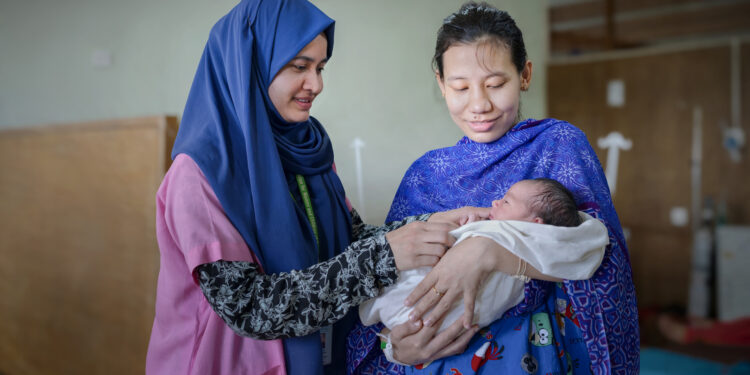Breastfeeding and Human Milk

Background
Breastfeeding and use of human milk are unequalled ways of providing ideal food for the healthy growth and development of infants and young children. It is also an integral part of the reproductive process with important implications for women’s health. Breast milk provides all the energy and nutrients that the infant needs for the first months of life. Exclusive breastfeeding for six months and continued breastfeeding for two years with appropriate complementary foods is the optimal way to feed infants and young children. This recommendation includes HIV+ women taking antiviral drugs.
To enable women and gender diverse people to establish and sustain exclusive breastfeeding, important actions include initiation of breastfeeding within the first hour of life and support of breastfeeding on demand.
Breast milk promotes infants’ sensory and cognitive development and protects them against infectious and chronic diseases. Breastfeeding contributes to the health and well-being of mothers by helping to space births and reducing the risk of ovarian and breast cancer. Increasing breastfeeding to near-universal levels could prevent 823,000 deaths in children younger than five years. It is also a secure way of feeding and is safe for the environment. Breastfeeding and use of human milk have economic benefits for individuals and countries.
Lactation is a natural physiological process, but breastfeeding is a learned behaviour. Active postpartum support is required for establishing and sustaining appropriate breastfeeding practices, especially mothers of premature babies. While improved maternity services help to increase the initiation of exclusive breastfeeding8, consistent education and support throughout the health system are required to help mothers sustain exclusive breastfeeding9.
In 2023 the Lancet reported formula sales on the rise, emphasising the need for women and families to receive accurate information about the benefits of breastfeeding and use of human milk especially as it pertains to premature babies. This information enables women to make informed decisions as to how their newborn will be nourished.
Position
ICM supports the recommendation of the World Health Organization for exclusive breastfeeding for six months11. Further, ICM supports the Convention on the Rights of the Child, particularly article 24, in its aspirations for children’s health.
Given this, ICM will:
- Actively work with other international organisations and government agencies to promote and support breastfeeding and the use of human milk.
- Advocate that HIV-positive, childbearing women have a right to information about infant feeding options to make an informed choice. Women also have a right to receive support to achieve their chosen method of feeding their newborns.
- Utilise its communication channels with midwives’ associations to keep them informed on developments in breastfeeding, lactation, and best use of milk banks.
- Ensure that within any document relating to the provision of care to women and their newborns there will be an element about the role of midwives in protecting, supporting, and promoting breastfeeding.
Recommendations
Member associations are urged to:
- Work with national and international organisations to promote and support breastfeeding, the use of human milk and establishment of milk banks.
- Share with others their experiences of policy and information initiatives and of supporting HIV-positive women in making and carrying out appropriate feeding choice.
- Encourage their midwife members to educate other health professionals on the importance of breastfeeding and human milk.
- Ensure midwifery education programmes contain adequate provisions for students to gain competency in supporting breastfeeding women and the use of human milk.
- Encourage their midwife members to accept their unique and vital role in the promotion of breastfeeding at all levels of the communities within which they live2
- Prohibit any form of promotion of breast milk substitutes.
- Proactively seek government legislation that promotes breastfeeding.
- Monitor vendors’ compliance with the International Code of Marketing of Breast-milk Substitutes13.
- Work with government agencies to support legislation and provision of community support to breastfeeding.
- Positively support breastfeeding in the workplace and public places.
Related ICM documents
Other Relevant Documents
- International Pediatric Association (IPA), International Confederation of Midwives (ICM), International Federation of Gynecology and Obstetrics (FIGO). (2010). Joint Statement on Breastfeeding including Breastfeeding by HIV-Infected Mothers. International Journal of Gynecology and Obstetrics 114 (2011): 89–90.
- Kramer MS, Kakuma R. (2012). Optimal duration of exclusive breastfeeding. Cochrane Database Systematic Review. Retrieved from: http://www.cochrane.org/CD003517/PREG_optimal-duration-of-exclusive-breastfeeding.
- The Lancet. (2023). Unveiling the predatory tactics of the formula milk industry. The Lancet, 401(10375), 409. https://doi.org/10.1016/s0140-6736(23)00118-6
- Pérez-Escamilla, R., Tomori, C., Hernández-Cordero, S., & Baker, P. (2023). Breastfeeding: Crucially important, but increasingly challenged in a market-driven world. The Lancet, 401(10375), 472–485. https://doi.org/10.1016/s0140-6736(22)01932-8
- Rollins, NC et al. (2016). Why invest, and what it will take to improve breastfeeding practices? The Lancet, 387: 491-504.
- United Nations Children’s Fund (UNICEF). (1989). Convention on the Rights of the Child. Retrieved from: http://www.ohchr.org/Documents/ProfessionalInterest/crc.pdf
- United Nations Children’s Fund (UNICEF). (2005). Innocenti Declaration 2005 on Infant and Young Child Feeding. Retrieved from: https://www.unicef-irc.org/publications/pdf/declaration_eng_p.pdf
- Victora CG, Bahl R, Barros A et al. (2016). Breastfeeding in the 21st century: epidemiology, mechanisms, and lifelong effects. The Lancet, 387:475-490.
- World Alliance for Breastfeeding Action (WABA). (2016). Breastfeeding: A key to Sustainable Development. Retrieved from: http://worldbreastfeedingweek.org/.
- World Health Assembly. (2001). WHA Resolution 54.2 Infant and young child nutrition. Retrieved from: http://www.who.int/nutrition/topics/WHA54.2_iycn_en.pdf?ua=1.
- World Health Organisation. (1981). International Code of Marketing of Breast-milk Substitutes. Retrieved from: http://www.who.int/nutrition/publications/code_english.pdf
- World Health Organization, United Nations Children’s Fund (UNICEF). (2009). The Baby Friendly Hospital Initiative. Retrieved from: http://www.who.int/nutrition/publications/infantfeeding/bfhi_trainingcourse/en/
- World Health Organisation, United Nations Children’s Fund (UNICEF), International Baby Food Action Network. (2016). Marketing of Breast-milk Substitutes: National Implementation of the International Code. Status Report 2016. Geneva: World Health Organisation. Retrieved from: https://www.unicef.org/lac/20160509_WHO_UNICEF_IBFAN_2016_Code_Status_Report_EN.pdf
- WHO Breastfeeding. https://www.who.int/healthtopics/breastfeeding#tab=tab_1 2021
- WHO Scope and impact of digital marketing strategies for promoting breastmilk substitutes. World Health Organization, Geneva2022
Adopted at Brisbane International Council meeting, 2005
Revised at Bali International Council meeting and merged with Exclusive breastfeeding and HIV infection 2023
Due for next review, 2026
PS2011_004 V2023


